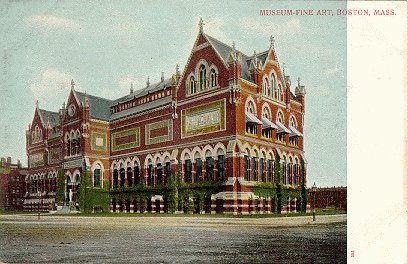 (Destroyed)
John H. Sturgis and Charles Brigham, Boston; 1870, Ruskinian Gothic style
[Present MFA, Huntington Avenue, Classical Revival style 1907-09 by Guy
Lowell
(Destroyed)
John H. Sturgis and Charles Brigham, Boston; 1870, Ruskinian Gothic style
[Present MFA, Huntington Avenue, Classical Revival style 1907-09 by Guy
Lowell
Predating the design of Old South, the original building of the Museum of Fine Arts demonstrated the prevailing influence of John Ruskin in matters of architecture, painting, and aesthetics. Designed by John H. Sturgis and Charles Brigham, Boston, in 1870, its polychrome exterior and pointed arches were ultimately derived from Venetian Gothic models. The architects, however, were probably more inspired by English Victorian precedents, especially two recently built museums. The University Museum in Oxford (1855-60), by B. Woodward, was designed with the direct cooperation of Ruskin. The long, coherent block with regular window openings, pitched roof, and central entrance are similar. Sturgis and Brigham are credited with introducing terra cotta (cast clay, often painted with a fired glaze) as a decorative building element, importing the material from Stoke-on-Trent, England. The innovative use of terra cotta was probably inspired by the use of decorative reliefs in terra cotta in the buildings of the Victoria and Albert Museum, begun 1866. The Boston Museum of Fine Arts was the first museum created by a voluntary group of citizens coming together for the benefit of the community, starting off with a mission that relied on the work of many to succeed. The Metropolitan Museum of Art was also incorporated in 1870, but plans for Boston's institution had begun years before. Early progress towards a Museum was encouraged by the already established Boston Athenaeum (founded in 1807), whose library and art collection focused on Boston's history. Many of the early paintings first exhibited in the Museum were portraits on loan from the Athenaeum. *Click here for a brief history of the Boston Museum of Fine Arts.